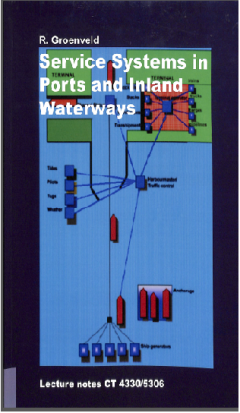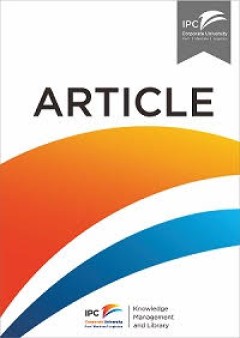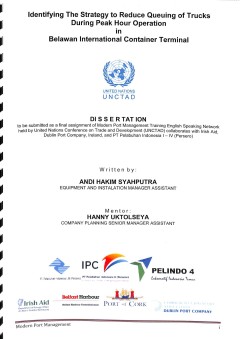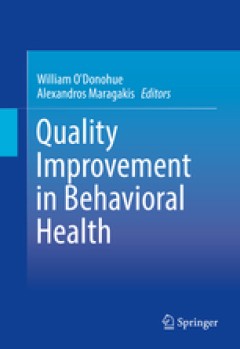Ditapis dengan

The six sigma way : how GE, Motorola, and other top companies are honing thei…
This title is an implementation blueprint for Six Sigma! ""The Six Sigma Way" demystifies Six Sigma with a real-world 'how-to 'guide. A good investment for any business planning to launch Six Sigma." - John Biedry, VP Quality and Compliance, Sears Home Services. Cost reduction ...productivity improvement ...customer retention ...these are the promises of the Six Sigma quality management system.…
- Edisi
- -
- ISBN/ISSN
- 0-07-135806-4
- Deskripsi Fisik
- xxiv, 422 p., ; illus : 24 cm ; index
- Judul Seri
- -
- No. Panggil
- LC 658.562 PAN s

Service Systems in ports and inland waterways
- Edisi
- 2001
- ISBN/ISSN
- -
- Deskripsi Fisik
- 76 p.
- Judul Seri
- -
- No. Panggil
- TXT PO GRO s C.1
- Edisi
- 2001
- ISBN/ISSN
- -
- Deskripsi Fisik
- 76 p.
- Judul Seri
- -
- No. Panggil
- TXT PO GRO s C.1

Total quality management (TQM)-an overview
- Edisi
- Vol. 17 Issue: 1, pp.15-19
- ISBN/ISSN
- -
- Deskripsi Fisik
- -
- Judul Seri
- The Bottom Line: Managing Library Finances
- No. Panggil
- ATC MG TAL t
- Edisi
- Vol. 17 Issue: 1, pp.15-19
- ISBN/ISSN
- -
- Deskripsi Fisik
- -
- Judul Seri
- The Bottom Line: Managing Library Finances
- No. Panggil
- ATC MG TAL t

Beyond performance management : Why, When, and How to Use 40 Tools and Best P…
There’s a bewildering array of management tools out there. And they all promise to help you excel at the toughest parts of your job: defining your organization’s strategic direction, managing customers and costs, and boosting workforce performance.But just 30 percent of these tools deliver as intended. Why? As Jeremy Hope and Steve Player reveal in Beyond Performance Management, while many…
- Edisi
- -
- ISBN/ISSN
- 978-1-4221-4195-3
- Deskripsi Fisik
- 387 p., ; 28 cm ; index
- Judul Seri
- -
- No. Panggil
- LC 658.31 HOP b

Identifying the strategy to reduce queuing of trucks during peak hour operati…
Belawan International Container Terminal especially serves export and import container by activities loading, discharge, receiving, delivery and behandle. These terminal in the main entrance gate container to North Sumatera, Aceh and most Riau. Recently, the terminal face the queue of trucks at peak time operation. These condition reduce terminal's level of service. This paper will evaluate a…
- Edisi
- -
- ISBN/ISSN
- -
- Deskripsi Fisik
- ix, 20 p., ; 33 cm
- Judul Seri
- -
- No. Panggil
- TD LO SYA i

Lean Six Sigma for Dummies
Maximize the quality and efficiency of your organization If you want to make your organization or team more productive, you have to change the way it thinks. Combining the leading improvement methods of Six Sigma and Lean, this winning technique drives performance to the next level. But the jargon-packed language and theory of Lean Six Sigma can be intimidating f…
- Edisi
- 2nd ed.
- ISBN/ISSN
- 978-1-119-95370-8
- Deskripsi Fisik
- xvi, 300p. ; 24cm.
- Judul Seri
- -
- No. Panggil
- MG MOR l

A Manager's Guide to ISO22301
Have you ever wondered whether your business continuity plan is any good, or whether you've even got a business continuity plan? Anyone can write a simple document, call it a business continuity plan and hope for the best. But, unless you know that it will do what it is supposed to, it may be a wasted investment. This practical guide to the ISO22301 business continuity management system standar…
- Edisi
- -
- ISBN/ISSN
- 978-1-84928-467-7
- Deskripsi Fisik
- x, 226p. ; 22cm.
- Judul Seri
- -
- No. Panggil
- TXT MG DRE a

Increasing the benefits of product-level benchmarking for strategic eco-effic…
Widely accepted classifications of benchmarking distinguish between different levels of benchmarking. Strategic-level benchmarking is considered to be of a higher sophistication than product-level benchmarking. Such strategic benchmarking would be based on process information instead of product information. The purpose of this paper is to research the possibility of obtaining strategic-level in…
- Edisi
- Vol. 14 No. 6, 2007 pp. 711-727
- ISBN/ISSN
- 1463-5771
- Deskripsi Fisik
- 19 p.
- Judul Seri
- Benchmarking: An International Journal
- No. Panggil
- ATC MR WEV i

Cruise passengers' satisfaction: Cartagena de Indias
The purpose of this paper is to explain the onshore satisfaction of cruise passengers, in the port of call of Cartagena de Indias.
- Edisi
- Vol. 19 No. 1, 2012 pp. 52-69
- ISBN/ISSN
- 1463-5771
- Deskripsi Fisik
- 20 p.
- Judul Seri
- Benchmarking: An International Journal
- No. Panggil
- ATC MR BRI c

Quality indicators and capacity calculation for RoRo terminals
Road freight transportation has increased dramatically over recent years along with its impacts such as congestion, noise, and pollution. As a result, European and US governments have started policies to promote alternatives to road transportation, such as logistic chains containing a Short Sea Shipping (SSS) link. Road is, by definition, a more flexible means of transportation than shipping, w…
- Edisi
- Vol. 33, No. 8, December 2010
- ISBN/ISSN
- 1029-0354
- Deskripsi Fisik
- 24 p.
- Judul Seri
- Transportation Planning and Technology
- No. Panggil
- ATC LO FUS q

Integrated Storage Space Allocation and Ship Scheduling Problem in Bulk Cargo…
This study is motivated by the practice of large iron and steel companies, which have steady and heavy demands for bulk raw materials such as iron ore, coal, limestone and so on. These materials are usually transported to a bulk cargo terminal by ships (or to a station by trains). Once discharged, they are moved to and stored in bulk material stock yard, waiting for retrieval for production use…
- Edisi
- -
- ISBN/ISSN
- -
- Deskripsi Fisik
- 45 p.
- Judul Seri
- IIE Transactions
- No. Panggil
- ATC LO TAN i

‘Postponement’ in the Logistical Systems of New Automobiles Marketed in P…
Automobile production is a worldwide industry in which quality has always been a very prominent and pertinent issue. There exists, however, certain links in the logistical chain that involve local initiatives in the finishing of the final product – including final testing, repairs to breakdowns and damage that occurred during transport operations. There also exists a group of steps or links i…
- Edisi
- Vol. 18, No. 6, 681–696, August 2007
- ISBN/ISSN
- 1200–725
- Deskripsi Fisik
- 18p
- Judul Seri
- Total Quality Management & Business Excellence
- No. Panggil
- ATC LO MEN p

Quality assurance in the maritime port logistics chain: the case of Valencia,…
The provision of port services is an important link in international logistics. Historically, ports have constituted a bottleneck in maritime transport. Moreover, the quality of port services has been compromised by the complex internal port organisation and the considerable number of bodies that participate in the transfer of goods between ships and inland transport vehicles. The efficiency of…
- Edisi
- Volume 3 · Number 1 · 1998 · pp. 33–44
- ISBN/ISSN
- -
- Deskripsi Fisik
- 14P
- Judul Seri
- Supply Chain Management: An International Journal
- No. Panggil
- ATC PO LOP q

RESEARCH AND CONCEPTS Components of successful total quality management
According to the literature, quality management consists of a set of components: critical factors, tools, techniques and practices. The purpose of this paper is: to identify the components of total quality management (TQM), in order to make them known to managers and thus facilitate successful quality management implementation, and to show the situation of 106 ISO 9000 certified firms concernin…
- Edisi
- Vol. 17 No. 2, 2005 pp. 182-194
- ISBN/ISSN
- 0954-478X
- Deskripsi Fisik
- 13P
- Judul Seri
- RESEARCH AND CONCEPTS
- No. Panggil
- ATC MG TAR c

Adopting quality management principles to revitalise the facilities maintenan…
The purpose of this paper is to review the total quality management (TQM) philosophy and the quality management principles (QMPs) in facilities management (FM), and presents the findings of a recent FM study at the Port Authority of Trinidad and Tobago (PATT).
- Edisi
- Vol. 11 No. 3, 2010 pp. 197-209
- ISBN/ISSN
- Asian Journal on Qua
- Deskripsi Fisik
- 16P
- Judul Seri
- Asian Journal on Quality
- No. Panggil
- ATC MG PUN a

Surface sediment quality relative to port activities: A contaminant-spectrum …
Ports are facing increasing environmental concerns with their importance to the global economy. Numerousstudies indicated sediment quality deterioration in ports; however, the deterioration is not discriminated for each port activity. This study investigated a spectrumof contaminants (metals and organic pollutants) in surface sediments at 20 sampling points in Port Ningbo, China, one of the top…
- Edisi
- -
- ISBN/ISSN
- 0048-9697
- Deskripsi Fisik
- 9 p.
- Judul Seri
- Science of the Total Environment
- No. Panggil
- ATC PO HEN s

Build-up of toxic metals on the impervious surfaces of a commercial seaport
In thecontextofincreasingthreatstothesensitivemarineecosystembytoxicmetals,thisstudyin- vestigatedthemetalbuild-uponimpervioussurfacesspecific tocommercialseaports.Theknowledge generatedfromthisstudywillcontributetomanagingtoxicmetalpollutionofthemarineecosystem. The studyfoundthatinter-modaloperationsandmainaccessroadwayhadthehighestloadsfollowedby container storageandvehiclemarshallingsites…
- Edisi
- -
- ISBN/ISSN
- 0147-6513
- Deskripsi Fisik
- 6 p.
- Judul Seri
- Ecotoxicology and Environmenta lSafety
- No. Panggil
- ATC PO ATH b

Organisational performance improvement through quality award process particip…
The purpose of the study is to describe the activities initiated based on participation in a quality award process and with the intention to improve performance.
- Edisi
- Vol. 22 No. 9, 2005 pp. 894-912
- ISBN/ISSN
- 0265-671X
- Deskripsi Fisik
- 19 p.
- Judul Seri
- Organisational performance improvement through quality award process participation
- No. Panggil
- ATC MG ERI o C.1

Total quality management : the key to business improvement
- Edisi
- -
- ISBN/ISSN
- 978-94-011-1276-5
- Deskripsi Fisik
- xi, 188 p.
- Judul Seri
- -
- No. Panggil
- TXT MG PER t
- Edisi
- -
- ISBN/ISSN
- 978-94-011-1276-5
- Deskripsi Fisik
- xi, 188 p.
- Judul Seri
- -
- No. Panggil
- TXT MG PER t

Quality improvement in behavioral health
- Edisi
- -
- ISBN/ISSN
- 978-3-319-26209-3
- Deskripsi Fisik
- ix, 327 p.
- Judul Seri
- -
- No. Panggil
- TXT MG ODO q
- Edisi
- -
- ISBN/ISSN
- 978-3-319-26209-3
- Deskripsi Fisik
- ix, 327 p.
- Judul Seri
- -
- No. Panggil
- TXT MG ODO q

Quality assurance management
- Edisi
- -
- ISBN/ISSN
- 978-1-4899-7140-1
- Deskripsi Fisik
- xii, 377 p.
- Judul Seri
- -
- No. Panggil
- TXT MG FOX q
- Edisi
- -
- ISBN/ISSN
- 978-1-4899-7140-1
- Deskripsi Fisik
- xii, 377 p.
- Judul Seri
- -
- No. Panggil
- TXT MG FOX q

Controlling the sustainability of food supply chains
For the food industry, the depletion of arable land and a growing world population demand controlling the sustainability of agricultural inputs to the industry. Controlling the sustainability of these supplies means controlling the economic, social, and environmental performance of the supply chain. In practice, little is known about how companies can efficiently extend their existing supply ch…
- Edisi
- Vol. 10 Iss 1 pp. 7 - 10
- ISBN/ISSN
- -
- Deskripsi Fisik
- 7 p.
- Judul Seri
- Supply Chain Management: An International Journal
- No. Panggil
- ATC LO MEI c

Agile supply chain transformation matrix : an integrated tool for creating an…
The purpose of this paper is to propose a tool, the Agile Supply Chain Transformation Matrix (ASCTM), and the implementation methodology for a systematic approach to achieve agility in the supplier-buyer supply chain.
- Edisi
- Vol. 12 Iss 5 pp. 334 - 348
- ISBN/ISSN
- 1359-8546
- Deskripsi Fisik
- 18 p.
- Judul Seri
- Supply Chain Management: An International Journal
- No. Panggil
- ATC LO BAR a

New research : a new forecasting model for the diffusion of ISO 9000 standard…
ISO 9000 standards for quality system management are involving a higher and higher number of enterprises and organizations. This paper presents a detailed analysis of certification diffusion in Italy and in some European countries with similar economic structures. Benchmarking and evolution forecasts are based on the “logistic model”, traditionally used for studying biological growth phenom…
- Edisi
- Vol. 21 No. 1, 2004 pp. 32-50
- ISBN/ISSN
- 0265-671X
- Deskripsi Fisik
- 23 P.
- Judul Seri
- International Journal of Quality & Reliability Management
- No. Panggil
- ATC LO FRA n

A conceptual model for quality of service in the supply chain
The objective of this paper is to propose a model for assessing the quality of service at various interfaces of supply chain using third party logistics.
- Edisi
- Vol. 36 No. 7, 2006
- ISBN/ISSN
- -
- Deskripsi Fisik
- 32 p.
- Judul Seri
- International Journal of Physical Distribution & Logistics Management
- No. Panggil
- ATC LO VRA a

Knowledge and cultural diffusion along the supply chain as drivers of product…
The purpose of this paper is to widen the knowledge base on supply chain learning by exploring and explaining how an enterprise can compete and win in the international market by integrating quality management practices along its supply chain and, above all, by becoming the coordinator in a supply chain learning (SCL) network.
- Edisi
- Vol. 23 No. 2, 2012
- ISBN/ISSN
- -
- Deskripsi Fisik
- 29 p.
- Judul Seri
- -
- No. Panggil
- ATC MG BIO k

Knowledge and cultural diffusion along the supply chain as drivers of product…
The purpose of this paper is to widen the knowledge base on supply chain learning by exploring and explaining how an enterprise can compete and win in the international market by integrating quality management practices along its supply chain and, above all, by becoming the coordinator in a supply chain learning (SCL) network.
- Edisi
- Vol. 23 No. 2, 2012
- ISBN/ISSN
- -
- Deskripsi Fisik
- 29 p.
- Judul Seri
- The International Journal of Logistics Management
- No. Panggil
- ATC LO NON k

Adopting quality management principles to revitalise the facilities maintenan…
The purpose of this paper is to review the total quality management (TQM) philosophy and the quality management principles (QMPs) in facilities management (FM), and presents the findings of a recent FM study at the Port Authority of Trinidad and Tobago (PATT).
- Edisi
- -
- ISBN/ISSN
- -
- Deskripsi Fisik
- 15 p.
- Judul Seri
- -
- No. Panggil
- ATC MG NUR a

Near-port air quality assessment utilizing a mobile measurement approach
Mobile monitoring is a strategy to characterize spatially and temporally variable air pollution in areas near sources. EPA's Geospatial Measurement of Air Pollution (GMAP) vehicle e an all-electric vehicle is outfitted with a number of measurement devices to record real-time concentrations of particulate matter and gaseous pollutants e was used to map air pollution levels near the Port of Charl…
- Edisi
- -
- ISBN/ISSN
- -
- Deskripsi Fisik
- 8 p.
- Judul Seri
- Atmospheric Pollution Research
- No. Panggil
- ATC PO FEL n

Defining service quality in tramp shipping: conceptual model and empirical ev…
Tramp shipping constitutes a prominent segment of the shipping market. As customers increasingly seek value from service providers for low price but yet high quality services, there is a pressing need to understand critically what construe the service quality for the tramp sector. In this respect, however, no prior research has been conducted for this market segment. This study recognises the g…
- Edisi
- Volume 30 Number 1
- ISBN/ISSN
- -
- Deskripsi Fisik
- 29 p.
- Judul Seri
- The Asian Journal of shipping and logistic
- No. Panggil
- ATC PO THA d

Service quality and its relation to satisfaction and loyalty in logistics out…
The purpose of this paper is to investigate how perceived service quality influences both a shipper’s satisfaction and subsequent loyalty in third-party logistics outsourcing relationships.
- Edisi
- Vol. 20 No. 6, 2010 pp. 496-510
- ISBN/ISSN
- -
- Deskripsi Fisik
- 18 p.
- Judul Seri
- Managing Service Quality
- No. Panggil
- ATC LO GRA s

Short-run vs long-run trade-offs in outsourcing relationships: Impacts on loy…
The purpose of this paper is to report on a study of a shipper’s dilemma as a customer. Shippers desire both lower costs and good service levels, and this dilemma may lead in the long run to a trade-off consideration between staying loyal to existing service providers and seeking cost reductions from competing providers.
- Edisi
- Vol. 3 No. 3, 2010 pp. 211-225
- ISBN/ISSN
- -
- Deskripsi Fisik
- 17 p.
- Judul Seri
- Strategic Outsourcing: An International Journal
- No. Panggil
- ATC LO JUN s

Quality Management in Logistics: an Examination of Industry Practices
Purpose – The objective of the study is to examine the extent to which quality management practices, tools and methods are employed and adopted in Australian companies. Design/methodology/approach – To address the aim of the study, a survey instrument was developed and data were collected from a field research on a sample of manufacturing, retail, and logistics companies. Findings – T…
- Edisi
- Vol. 11 Iss 3 pp
- ISBN/ISSN
- 1359-8546
- Deskripsi Fisik
- 10 p
- Judul Seri
- Supply Chain Management: An International Journal
- No. Panggil
- ATC LO RAH q

Benchmarking for spare parts logistics
This article shows the use of benchmarking for the spare parts logistics in the German mechanical industry (investment goods or capital goods). After pointing out the areas of benchmarking application, the use of total function deployment (TFD) for the evaluation of benchmarking metrics is explained. With TFD customer requirements on spare parts supply and the process structure of spare parts l…
- Edisi
- Vol. 6 No. 1, 1999
- ISBN/ISSN
- -
- Deskripsi Fisik
- 20 p.
- Judul Seri
- Benchmarking: An International Journal
- No. Panggil
- ATC LO EST b

The effects of technology and TQM on the performance of logistics companies
Total quality management (TQM) and technology are fast becoming essential features of business strategy for the success of many leading organizations in the world. More and more companies are using technology and adapting TQM for sustaining competitiveness in the marketplace. TQM works well for internal integration of logistics companies and they can benefit from the use of technology, includin…
- Edisi
- Vol. 36 No. 3, 2006
- ISBN/ISSN
- -
- Deskripsi Fisik
- 22 p.
- Judul Seri
- International Journal of Physical Distribution & Logistics Management
- No. Panggil
- ATC LO YIN t

Revenue estimation for logistics customer service offerings
In logistics strategy, it is now being recognized that revenue generation is as important as cost reduction. Although it has long been known that logistics customer service has a positive effect on customer satisfaction, little research has been conducted to determine precisely the degree to which logistics customer service affects sales and generates the revenues for the firm. The purpose of t…
- Edisi
- Vol. 17 No. 1, 2006
- ISBN/ISSN
- -
- Deskripsi Fisik
- 19 p.
- Judul Seri
- The International Journal of Logistics Management
- No. Panggil
- ATC LO BAL l

Logistics service quality and its effects on customer satisfaction in the man…
The purpose of this paper is to implement a multi-criteria preference disaggregation approach to measure logistics service quality (LSQ) of manufacturing companies’ supply chains.
- Edisi
- Vol. 9 No. 2, 2014
- ISBN/ISSN
- -
- Deskripsi Fisik
- 25 p.
- Judul Seri
- Journal of Modelling in Management
- No. Panggil
- ATC LO BIN l

Logistics of international express shipping and air traffic
The paper studies the relations between logistics of international express shipments and air traffic analysing the basic characteristics of international express shipments that are carried by combined transport, usually road vehicles and aircraft. The paper indicates the possibility of optimising individual technological processes in the logistic chain of express shipments distribution. It anal…
- Edisi
- Vol. 25, 2013, No. 3, 209-215
- ISBN/ISSN
- -
- Deskripsi Fisik
- 8 p.
- Judul Seri
- -
- No. Panggil
- ATC LO KAV l

Becoming a “world class” company with logistics service quality
A “world class” organization must provide high levels of logistics service quality to customers. Knowledge of customer expectations and an understanding of the firm's performance on logistics service attributes relative to competitors are vital to achieving service excellence. Research studies in four industries identify the most important logistics service attributes in business‐to‐bus…
- Edisi
- Vol. 3 Issue: 1, pp.73-81
- ISBN/ISSN
- -
- Deskripsi Fisik
- 12 p.
- Judul Seri
- The International Journal of Logistics Management
- No. Panggil
- ATC LO LAM b

Towards a holistic approach to logistics quality deficiencies
The first purpose of this paper is to define the relevant types of logistics quality deficiencies (LQDs) in the dyadic order fulfillment process. The second purpose is to find the variables for measuring the different types of LQDs.
- Edisi
- Vol. 24 Iss 9 pp. 944 - 957
- ISBN/ISSN
- -
- Deskripsi Fisik
- 16 p .
- Judul Seri
- International Journal of Quality & Reliability Management
- No. Panggil
- ATC LO FOR s

The logistics services outsourcing dilemma: quality management and financial …
Logistics has become an essential service for synchronous companies. Many companies have recognized the potential benefits gained through a high quality system of logistics services, which are provided either internally or externally by a third party logistics company (3PL). The 3PL is positioned between the company and its customers, in a new-shaped logistics triad, having a crucial role in ha…
- Edisi
- Volume 15 · Number 6 · 2010 · 438–453
- ISBN/ISSN
- -
- Deskripsi Fisik
- 18 p.
- Judul Seri
- Supply Chain Management: An International Journal
- No. Panggil
- ATC LO VOU t

The moderating effects of technological and demand uncertainties on the relat…
The purpose of this paper is to test the moderating effects of technological and demand uncertainties on the relationship between supply chain integration and customer delivery performance.
- Edisi
- Vol. 41 No. 3, 2011
- ISBN/ISSN
- -
- Deskripsi Fisik
- 27 p.
- Judul Seri
- International Journal of Physical Distribution & Logistics Management
- No. Panggil
- ATC LO YEW t

Logistics case study based research: towards higher quality
This paper aims to assess the quality of the case study based research approach as documented in articles published during the past 13 years, based on a synthesis of indicators for the quality criteria truth-value, transferability, and traceability.
- Edisi
- Vol. 42 No. 3, 2012
- ISBN/ISSN
- -
- Deskripsi Fisik
- -
- Judul Seri
- 23 p.
- No. Panggil
- ATC LO JAS l

A supply chain diagnostic tool
How can a third-party logistics (3PL) provider decide whether or not there is a viable opportunity to serve the needs and desires of potential clients? To answer this question, a tool is needed that can help determine if there are problems, inefficiencies, or needed improvements in a client’s, or a potential client’s, supply chain that the 3PL can effectively address. Most diagnostic tools …
- Edisi
- Vol. 34 Iss 10 pp. 827 - 855
- ISBN/ISSN
- 0960-0035
- Deskripsi Fisik
- 31 p.
- Judul Seri
- International Journal of Physical Distribution & Logistics Management
- No. Panggil
- ATC LO FOG a

The state of quality in logistics: evidence from an emerging Southeast Asian …
The importance of the logistics function has increased dramatically at many firms as comparative priorities have shifted from production quality to delivery and flexibility. At the same time, however, there have been few comprehensive studies on the implementation of TQM practices in the logistics function. This paper examines the implementation of quality management practices in the logistics …
- Edisi
- Vol. 21 No. 4, 2004
- ISBN/ISSN
- -
- Deskripsi Fisik
- 17 p.
- Judul Seri
- International Journal of Quality & Reliability Management
- No. Panggil
- ATC MG MIL t

Improving the service quality of ocean container carriers: an Indian case study
The purpose of this paper is to assist ocean container carriers in their service quality improvement strategies to ensure breakthrough performance in India.
- Edisi
- Vol. 19 No. 6, 2012
- ISBN/ISSN
- -
- Deskripsi Fisik
- 23 p.
- Judul Seri
- Benchmarking: An International Journal
- No. Panggil
- ATC LO KAN i

Service quality measurements in ports of a developing economy : Nigerian port…
Identifies and assesses the key determinants of service quality and determines the quality of service offered by two ports in Nigeria using the SERVQUAL model. The main service attributes that are important to port users are determined. Relevant literature is reviewed to give relevance to the survey. Data for the study was collected via a well-structured questionnaire, analysed, and perception-…
- Edisi
- Volume 14 · Number 6 · 2004 · pp. 487-495
- ISBN/ISSN
- 0960-4529
- Deskripsi Fisik
- 11 p.
- Judul Seri
- -
- No. Panggil
- ATC PO OGB s

Benefits of implementing management system standards - a case study of certified
The purpose of this paper is to explore the extent of implementing management system standards among ISO (and other) certified companies in the Pearl River Delta and its effect on the perceived benefits.
- Edisi
- -
- ISBN/ISSN
- -
- Deskripsi Fisik
- 14 p
- Judul Seri
- -
- No. Panggil
- ATC MG RIV b

Stochastic two stage model with probabilistic constraints for optimal rescue …
We propose a mathematical model to minimize the overall response time consisting of the current ship incident and future potential incident that might occur at some other site in the sea. Considering the uncertainties in both objective function and constraints, a two stage stochastic programming model having chance constraints for the number of rescue ships to be required at the potential incid…
- Edisi
- Volume 26 Number 2
- ISBN/ISSN
- -
- Deskripsi Fisik
- 14 p.
- Judul Seri
- -
- No. Panggil
- ATC MR KIM s

A quality management framework for seaports in their supply chains in the 21s…
For seaports to be competitive and sustainable in the long-term in a turbulent and hyper-competitive market, a re-examination of success factors, organizational structures, and management practices is required. As seaports have continued to evolve and become further integrated and embedded in their supply chains, the issue of ensuring quality management practices becomes of greater interest. T…
- Edisi
- Volume 27 Number 3
- ISBN/ISSN
- -
- Deskripsi Fisik
- 24 p.
- Judul Seri
- The Asian Journal of Shipping and Logistics
- No. Panggil
- ATC LO TRA a
 Karya Umum
Karya Umum  Filsafat
Filsafat  Agama
Agama  Ilmu-ilmu Sosial
Ilmu-ilmu Sosial  Bahasa
Bahasa  Ilmu-ilmu Murni
Ilmu-ilmu Murni  Ilmu-ilmu Terapan
Ilmu-ilmu Terapan  Kesenian, Hiburan, dan Olahraga
Kesenian, Hiburan, dan Olahraga  Kesusastraan
Kesusastraan  Geografi dan Sejarah
Geografi dan Sejarah